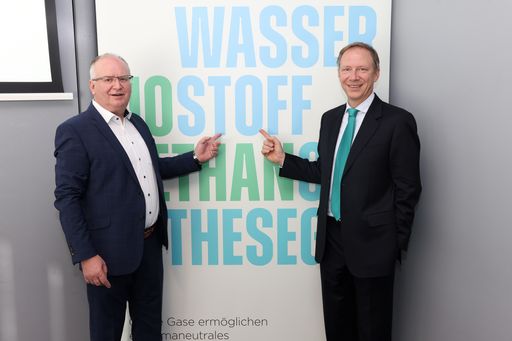“The exit from fossil fuels carries the risk of a significant supply gap,” says Stefan Wagenhofer, Vice President of the Austrian Association for Gas and Water (ÖVGW) and Managing Director of Gas Connect Austria GmbH. Even with a doubling of electricity generation in Austria and a significant increase in other renewables such as wood and geothermal energy, there remains a significant proportion of fossil fuels that can only be replaced by climate-neutral gases.
The main thrust: the rapid construction of hydrogen and biomethane production plants, the development and implementation of a hydrogen import strategy and the development of the necessary pipeline network in order to be able to guarantee a secure energy supply in Austria in the long term. “We now need political support and clear framework conditions for investments in Austria’s gas infrastructure,” says the vice president of the ÖVGW.
Technical homework done
“Extensive research work has been carried out in recent years so that climate-neutral gases such as hydrogen or biomethane can enter the Austrian gas pipeline network,” emphasizes Manfred Pachernegg, Chairman of the ÖVGW Research Advisory Board and Managing Director of Energienetze Steiermark: “We have the hydrogen compatibility of our existing gas network, right down to the corresponding fittings and gas end devices such as industrial gas burners or heating systems.” The result: In Austria, 97 percent of the gas pipeline network is already hydrogen-compatible. “Already today, 100 percent of biomethane and up to ten percent of hydrogen can be fed into the gas network without any technical concerns,” says Pachernegg. In the future, 100% hydrogen will be transported in part of the current gas network. This means that the systemic and technical prerequisites for a climate-neutral gas supply have largely been created.
The demands specific
In order to ensure the expansion and conversion of the domestic gas pipeline network as well as the connection to the networks in neighboring countries and to achieve a secure and cost-efficient energy supply, the ÖVGW is calling on the next federal government to:
- Clear rules: Rapid further development of the gas infrastructure is a prerequisite for a successful ramp-up of hydrogen and biomethane. A secure and diversified energy supply requires gas to support increasingly volatile electricity generation. However, this requires a clear and, above all, practical legal framework.
- Investments in the Austrian gas infrastructure: This includes, in particular, the rapid development of a hydrogen network as well as political support for strengthening the upstream, foreign networks, for example for the southern corridor (SoutH2corridor). The expansion and conversion of the pipeline network will also create the conditions to position Austria as a future hydrogen hub in Europe.
- Sector coupling: A holistic infrastructure plan that makes optimal use of the integration of different energy sources and resources. A holistic plan that links gas, hydrogen, electricity, district heating and CO2 networks leads to an efficient and cost-effective energy transition. Overproduction of renewables, which would otherwise be curtailed, can be fed into the pipeline network as hydrogen, thus relieving the burden on the electricity network. High-performance gas networks, but above all the consideration of sufficient gas storage capacities, compensate for fluctuations, particularly in the power supply, and guarantee security of supply.
- Creation of a practical legal framework that enables planning and investment security for the development of a hydrogen infrastructure – ideally using existing market structures and models. In order to enable a rapid ramp-up, the design should, if possible, be analogous to the proven gas market model and make use of the existing market structures. Infrastructure development will initially require financing models with government subsidies.
- Rapid adoption of a renewable gas law to develop domestic biomethane potential. Similar to the promotion of green electricity, the law is intended to stimulate domestic production with market premiums and competitive incentives. In addition, there is a need to quickly implement an import strategy for green gases such as the SoutH2Corridor for hydrogen or the H2EU+Store project.
Hydrogen as the energy of the future
Hydrogen will play a major role in the climate-neutral energy supply of the future. “Austria’s gas industry is already technically prepared for the switch to hydrogen,” emphasizes Wagenhofer. What is missing, however, is a binding legal framework, a functioning market model and financing for the ramp-up of the new hydrogen sector. “Now is the right time to set the course for the future. With the right measures, Austria can not only secure its energy supply, but also play a key role in Europe in the hydrogen economy,” he emphasizes.
Europe’s gas infrastructure is being transformed
Europe plans to build a 40,000 km long H2 pipeline network – the H2 backbone – by 2040, which will be created by repurposing existing gas pipelines and building new ones. Austria can only maintain its role as a central energy hub if our country is integrated into the European hydrogen network.
Pachernegg concludes: “A rapid conversion of the gas infrastructure is crucial, especially in the initial phase, in order to successfully establish the hydrogen market. With an investment of around two billion euros, a high-performance hydrogen network can be built that is sufficiently dimensioned for the forecast demand and transit for the year 2050. Central hydrogen locations and import routes must be linked. The conversion of the distribution network to supply industrial plants, large-volume storage systems and modern gas power plants with hydrogen also plays a central role.”
About the ÖVGW
The Austrian Association for Gas and Water (ÖVGW) is the voluntary representation of Austrian gas network operators and water supply companies. It counts all gas network operators and around 260 companies in the water sector among its members. The ÖVGW represents more than 1,500 water suppliers through cooperation with regional associations. These supply around 80 percent of the population with drinking water.
